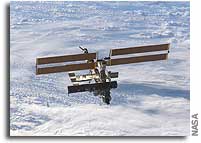NASA International Space Station Status Report 25 February 2005

The crew members aboard the International Space Station are winding down a week that saw them preparing for the arrival of a new cargo spacecraft and helping achieve a milestone in Station robotics operations that has the potential for long-term exploration applications.
Expedition 10 Commander and NASA Station Science Officer Leroy Chiao and Flight Engineer Salizhan Sharipov spent part of the week packing the Russian Progress supply spacecraft with trash and other items no longer needed on the Station. They closed the hatch between Progress and the Zvezda Service Module this morning in advance of the ship’s undocking Sunday.
The unpiloted spacecraft will be undocked Sunday at 11:06 a.m. EST. A pair of engine firings will place the vehicle in an orbit a safe distance away from the Station to allow Russian flight controllers to conduct engineering tests before it is commanded to reenter the Earth’s atmosphere on March 9 and burn up. The Progress arrived at the Station in December, bringing food and supplies to Chiao and Sharipov.
The next Progress that will be sent to the Station will be moved to its launch pad at the Baikonur Cosmodrome in Kazakhstan tomorrow for its liftoff, planned for Monday at 2:09 p.m. EST. Docking is scheduled on Wednesday, March 2, at 3:15 p.m. EST. NASA TV will provide live coverage of the docking beginning at 2:30 p.m. EST. This will be the 17th Progress to dock with the Station.
The new Progress is loaded with more than two tons of supplies and food, including 2,932 pounds of spare parts, equipment, experiment hardware and life-support system gear, 386 pounds of propellent, 242 pounds of oxygen and air, and 1,071 pounds of water. Eighty six food containers are also loaded into the Progress, good for more than 160 days of additional provisions above what is already aboard, in the Station’s pantry.
Among the other key U.S. items being carried to the Station on the supply ship is a new heat-exchanger device for the cooling of U.S. spacesuits in the Quest Airlock. It will replace a heat exchanger that introduced rust in the suits last year, canceling Station spacewalks out of the U.S. segment. The new component will be installed by Chiao next month and checked out by the next crew, Expedition 11, to permit the airlock to be used again this summer. Also being delivered are digital cameras and lenses that the Expedition 11 crew will use to collect imagery of the heat-protective tiles of the Shuttle Discovery during its approach to the Station during this spring’s Return to Flight mission, STS-114, prior to docking. That imagery will assist in helping mission managers determine whether Discovery’s thermal protection system is intact and able to support a safe return to Earth.
Earlier today, engineers completed a two-day test of new software that was loaded into the Canadarm2 robotic arm last month to allow remote control operation of the space crane from Mission Control, rather than by the crew on board. The test was declared a success.
Chiao stood by at the robotic work station in the Destiny laboratory, ready to take over manual operation of the arm if necessary, but the automated commands loaded into the arm enabled Canadarm2 to move effortlessly throughout the demonstration. Its shoulder and wrist joints and its latching end effector were all exercised, verifying a new capability that may yield valuable data for designers of more complex robotic hardware for spacecraft that will support the Vision for Space Exploration.
Chiao also installed a rotor pump in one of the U.S. space suits on the Station today to configure it properly for its return to Earth on the STS-121 Shuttle mission to the outpost, targeted for mid-July.
On the research front, Chiao conducted a session this week with the Dust and Aerosol Measurement Feasibility Test, or DAFT. The experiment, developed at NASA’s Glenn Research Center in Cleveland, is designed to test the effectiveness of a device that counts ultra-fine dust particles in a microgravity environment. This is a precursor to the next generation of fire detection equipment for space exploration vehicles.
The device, called a P-Trak (registered trade mark), counts the dust particles by passing dust-laden air through a chamber of vaporous isopropyl alcohol. When a droplet of alcohol condenses over an ultra-fine dust particle, the particle becomes large enough to break the light beam and be counted. NASA’s payload operations team at NASA’s Marshall Space Flight Center, Huntsville, Ala., coordinates science activities on Space Station.
Information about crew activities on the Space Station, future launch dates and Station sighting opportunities from Earth, is available on the Internet at:








